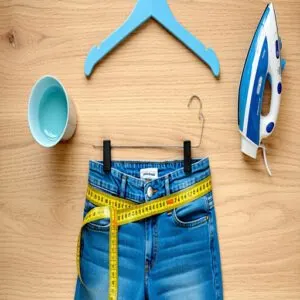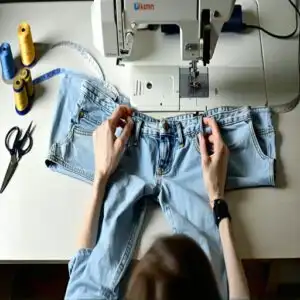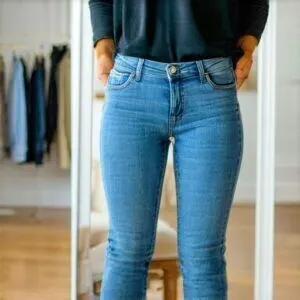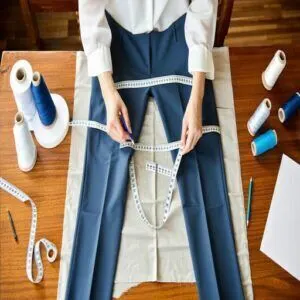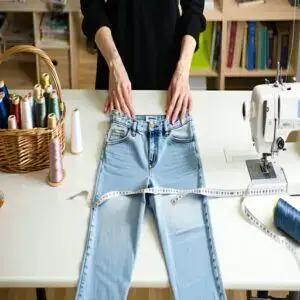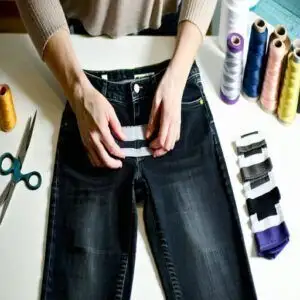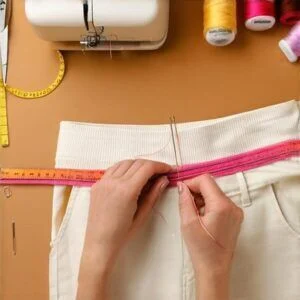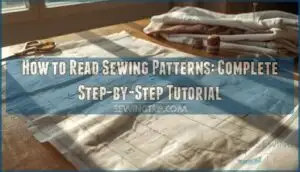This site is supported by our readers. We may earn a commission, at no cost to you, if you purchase through links.
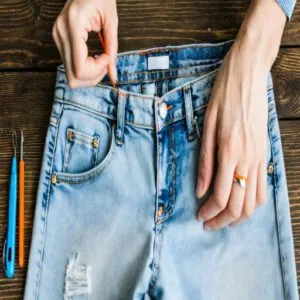
If the pants have extra fabric within the seam allowance, you can resew the edges to add width.
For a more flexible fit, insert elastic into the side seams or replace the waistband entirely with elastic.
Another option is sewing in triangular fabric gussets at the waist sides, blending colors for a seamless look.
With a few sewing basics, you can make your pants roomier and more comfortable, no tailor required.
Try it—it’s easier than you think!
Table Of Contents
- Key Takeaways
- Expanding Pants Waist Without Sewing
- How to Expand Pants Waist With Sewing
- Tailoring Considerations for Pants Expansion
- Making Waistband Bigger With Sewing
- Making Jeans Bigger at The Waist
- Making Dress Pants Waist Bigger
- Additional Tips for Pants Expansion
- Using Waist Extenders for Quick Fixes
- Techniques for Making Hips and Thighs Bigger
- Altering Waistband Size With Elastic Inserts
- Frequently Asked Questions (FAQs)
- Conclusion
Key Takeaways
- You can expand your pants waist by unpicking seams and adding extra fabric from the seam allowance – this works best with dress pants that often have built-in extra material.
- For a no-sew solution, you’ll get quick results by soaking the waistband in warm water and stretching while damp, or using a sturdy hanger to stretch overnight.
- If you’re comfortable with basic sewing, you can insert elastic panels into the side seams or replace the entire waistband with an elastic one for maximum comfort and flexibility.
- You’ll need to decide between DIY fixes ($0-30 in materials) and professional tailoring ($15-100 depending on complexity) – for pants under $40, buying new ones might be more cost-effective.
Expanding Pants Waist Without Sewing
You don’t need a sewing machine to make your pants fit better around the waist.
Simple techniques like using warm water, steam, or a clothes hanger can give your waistband a noticeable stretch with minimal effort.
Warm Water Soak Method
Want to know how to expand pants waist with zero sewing?
Try the warm water soak method.
Fill a sink or tub with warm water (not hot!) to avoid damaging the fabric.
Submerge your pants for 15-20 minutes.
Next, gently stretch the waistband outward from all sides.
Finally, air dry them stretched over a sturdy hanger to guarantee proper fabric recovery.
Simple, right?
Spray Bottle While Wearing Method
A simple water spray is all you need for quick waist expansion.
No needles, no fuss. Here’s how to expand your pants:
- Grab a spray bottle, fill it with warm water, and mist the waistband until damp.
- Slip the pants on, ensuring the waistband fits snugly.
- Stretch, squat, or do light lunges for 15-20 minutes as the fabric stretches naturally.
Comfortable pants, no sewing required!
Clothes-Hanger Method
Got tight pants? Try this simple hack using hanger techniques for waist stretching.
Start by dampening the waistband with warm water and stretching it evenly over a broad, sturdy hanger.
For overnight expansion, pick a hanger slightly wider than your desired fit.
Here’s a quick breakdown:
| Steps | Tools Needed | Tips for Success |
|---|---|---|
| Dampen waistband | Spray/warm water | Avoid soaking; just moisten. |
| Stretch over hanger | Wooden/plastic | Make certain hanger fits waistband. |
| Leave overnight | Drying methods | Even out fabric to prevent warps. |
This no-sew method offers a simple way to expand your waistband without sewing.
Steaming Method
Steam is your secret weapon for waistband expansion, and it works wonders on natural fabrics like cotton or wool.
Here’s how to use steam effectively for fabric relaxation and garment expansion:
- Hang your pants in a steamy bathroom during a hot shower.
- Use a handheld steamer for targeted heat application.
- Wear the pants damp, then squat or bend for fabric stretching.
- Repeat steam stretching if needed for better waist expansion.
- Don’t overdo it – gentle steaming prevents fabric warping.
This approach makes waistband expansion a breeze!
Hair Elastic
A hair elastic is a lifesaver when you need a quick fix for waistband expansion.
Just loop the elastic through your pants’ buttonhole and stretch both ends around the button.
You’ll instantly create extra breathing room with zero sewing!
Whether post-holiday meals or daily comfort, this hack works wonders.
Here’s a breakdown of elastic materials:
| Elastic Type | Stretch Amount | Best Uses |
|---|---|---|
| Thin | 0.5-1 inch | Lightweight fabrics |
| Medium | 1-2 inches | Jeans or casual wear |
| Thick | 2-3 inches | Heavy fabrics or denim |
Grab stretchy solutions to expand waist size in seconds!
How to Expand Pants Waist With Sewing
Feeling cramped in your favorite pants? Master these sewing techniques to enlarge your waistband like a pro.
With a few sewing tools and basic alteration methods, you’re ready to go.
There are several methods to achieve this:
- Insert V-shaped fabric panels into the side seams for up to 2 extra inches on each side.
- Let out the center back seam by unpicking and re-stitching closer to the edge—an easy inch gained.
- Replace the waistband with a stretchy elastic one for ultimate comfort.
- Add elastic inserts at the sides for flexible waist expansion.
Tailoring Considerations for Pants Expansion
When expanding your pants’ waist, it’s important to think about the cost, fabric, and construction.
A tailor can help maintain the fit and durability, but some alterations may not be worth the investment.
Can a Tailor Make Pants Waist Bigger?
Can a tailor expand your pants waist? Absolutely! Skilled pros use precise techniques to make pants bigger in the waist while preserving their original style.
They’ll remove seams, adjust belt loops, and add fabric panels or elastic inserts, depending on your pants’ construction and available fabric.
Tailors are especially great for formalwear, like dress pants, where even a small alteration can improve fit dramatically.
While it can be tempting to DIY, professional alterations deliver durability and polish you just can’t replicate at home.
Here’s a quick comparison:
| DIY Adjustments | Tailor Services |
|---|---|
| Budget-friendly | Higher cost, but better results |
| Requires basic sewing skills | Skilled alterations guaranteed |
| Limited fabric options | Wide fabric/elastic choices |
With them, waist expansion becomes effortless!
How Much Does It Cost to Tailor Pants?
Tailoring costs for pants vary, but you can expect to spend anywhere from $10 to $100 based on the work involved.
Simple waistband adjustments, like tightening or loosening, usually cost $15-$30. More complex alterations, like adding fabric panels, can reach $75-$100.
Here’s a quick breakdown:
- Basic waistband adjustments: Low-cost at $15-$30.
- Fabric insertions/pattern matching: Higher at $75-$100.
- Labor charges depend on location: $20-$50 hourly.
- High-end boutique tailoring: Costs substantially more.
For those looking to avoid these costs, considering non sewing methods can be a viable alternative.
Tailors often offer free consultations to provide specific estimates.
Should You Buy New or Alter?
Deciding whether to alter or replace your pants comes down to a mix of cost comparison and practicality.
Consider these points:
- Budget Planning: Is altering under 50% of the original cost?
- Fabric Choices: Higher-end pants often come with extra material for alterations.
- Time Investment: DIY can take 2–4 hours, especially for beginners expanding a waistband.
- Buying Decisions: For under $40 pants, buying new could save money and effort.
Tailor wisely!
Making Waistband Bigger With Sewing
Expanding a waistband with sewing gives you a custom fit that’s both practical and long-lasting.
With just a few simple techniques, you can adjust your pants to feel more comfortable and look great.
Inserting Elastic Into Side Seams
Expanding your pants’ waistband with elastic panel insertion is straightforward.
Open the side seams carefully, stitch elastic for a custom fit, and reinforce stress points to prevent tearing.
Use stretchy, durable materials like braided or knitted elastic.
Match thread color to keep things seamless.
This sewing technique works wonders as it combines flexibility with a snug fit—perfect for sewing pants waist adjustments.
Fabric selection guarantees comfort and extends the pants’ life.
To achieve a professional finish, consider learning about sewing elastic waistbands to improve your skills.
Center Back Seam Adjustment
To tackle a snug waistband, try a center back seam adjustment. It’s a go-to in pants alteration, especially for waistline adjustment.
- Use a seam ripper to carefully undo the center back seam (about 1-2 inches).
- Adjust according to your waist expansion needs.
- Sew closer to the fabric edge for a new seam.
- Add stitch reinforcement to prevent tearing.
When working with seams, understanding a seam ripper tool is essential for making precise adjustments.
Bonus tip: Great for subtle room without big changes!
Replacing Existing Waistband With Elastic
Switching to an elastic waistband is a game-changer for comfort, especially if your pants are too snug.
By sewing in an elastic waistband, you can achieve a custom fit without replacing the entire garment. The process isn’t as tricky as it sounds—just a mix of patience and simple sewing techniques.
Here’s what you’ll need to expand the waistband effectively:
- A seam ripper and sharp scissors to remove the old waistband.
- 1-inch elastic cut to your waist measurement plus 2 inches.
- Matching thread, a sewing machine, and sturdy pins.
- Elastic waist extenders for pants (optional).
After carefully removing the waistband, sew in the elastic using a zigzag stitch. Adding elastic panels gives flexibility, making it easy to enlarge pants’ waistbands with ease.
Making Jeans Bigger at The Waist
Expanding jeans at the waist can give you a more comfortable fit without compromising style.
By using simple sewing techniques or fabric inserts, you can adjust your jeans to fit perfectly around your waist.
Different Styles of Jeans
Different styles of jeans fit your waist differently, making it essential to pick ones that match your fit preferences.
Bootcut and straight-leg jeans are roomier, while skinny jeans cling tightly, often leading to the dreaded waist gaps.
| When altering jeans to better fit, understanding how to make jeans bigger is essential for a successful DIY project. Here’s a quick breakdown: | Style Options | Fit Preferences | Waist Trends |
|---|---|---|---|
| Bootcut | Relaxed through hips and thighs | Minimal waist gaps | |
| High-Waisted | Full coverage and support | Sits at natural waistline | |
| Distressed Jeans | Stretchy and forgiving waistband | Trendy and flexible |
When altering jeans waistband larger, aim for flexible fabrics.
For tricky fits, sewing to increase waist size of trousers might be the answer.
Shrinking and Expanding Jeans
Jeans can shrink or stretch, and knowing how to handle them saves frustration.
Denim care is key when managing size changes.
Here’s how:
- Shrink jeans by washing in hot water and tumble-drying—expect up to a 10% reduction.
- Stretch the waistband by wearing damp jeans while walking or sitting.
- Use steam to relax fibers; a handheld steamer or bathroom steam works wonders.
- Hand-stretch wet denim around the waistband for noticeable waist expansion.
Understanding jeans fabric and proper garment alteration techniques guarantees you’re in control of fit, whether stretching out or adjusting through sewing techniques.
Choosing The Right Size
Finding the right size jeans saves you from future waist adjustments.
Start by measuring yourself—your body measurements are your best guide.
Compare them to brand-specific size charts and fit guides since sizing varies.
Use a waist calculator for added accuracy.
Slip two fingers into the waistband when trying them on; it should feel snug but not tight.
Between sizes? Go bigger—it’s easier to alter with sewing techniques or pants sewing tweaks.
Making Dress Pants Waist Bigger
Expanding the waist of dress pants is simpler than you might think, especially since many designs include extra fabric in the seams.
With a few basic sewing tools and some careful adjustments, you can achieve a clean, custom fit that fits perfectly, which is the goal of altering the pants to make them more comfortable and suitable for the wearer, this process involves making precise adjustments.
Extra Fabric for Alterations
High-quality dress pants often hide a secret weapon—extra fabric tucked in the seams, perfect for waist expansion.
Skilled hands can carefully use this fabric to enlarge the pants waist by sewing without altering the appearance.
Gently check inside the waistband for this folded fabric.
With proper sewing techniques and the right alteration materials, like matching fabric panels or thread, this hidden detail makes waist alterations seamless and stress-free.
Styles of Dress Pants
Knowing your dress pants’ style is essential for successful waistband expansion.
Each style brings its own challenges:
- Pleated pants: Extra fabric makes these ideal for adjustments using sewing techniques.
- Flat-front styles: Limited seam allowances call for precision in expanding the waistband.
- Wide-leg options: Often forgiving, they provide ample fabric for modifications.
- Tapered or cuffed pants: Proportions might shift, so plan alterations carefully.
Whether Formal Wear or Casual Styles, understanding pants waist expansion keeps your adjustments sleek and on-trend.
Alteration Costs
When altering dress pants, understanding cost factors helps you plan your alteration budget.
Tailor estimates for altering waistlines vary: basic waist adjustments range from $15-$25, side seam extensions hit $25-$40, and replacing waistbands costs $35-$60.
A complete reconstruction could set you back $50-$100.
Weigh sewing fees against just buying new pants.
Need a quick fix? Try pants waist extenders from Joann Fabrics instead.
Professional alteration services can handle complex jobs, so ask, “Can tailors make waistline bigger?” and compare options before investing.
Additional Tips for Pants Expansion
You can easily adjust your pants with some extra tools and small tweaks.
Simple methods like adding extenders or sewing in fabric can give you a better fit without much hassle.
Cutting Side Seams and Sewing in Fabric
Tackling waist expansion through fabric insertion is easier than you think.
Start by cutting along the side seams using sharp scissors and creating a “V” shape down a few inches.
Choose fabric that matches your pants’ weight and stretch for a seamless panel addition.
Cut a rectangular piece an inch bigger than the “V,” pin it in place, and use a zigzag stitch for flexibility and durability.
Press the seams flat for a professional finish.
Thread selection matters—match it to your pants’ color for a polished look.
With these sewing tips, you’ll expand pants while keeping them stylish.
Using Waistband Extenders
Waistband extenders are a lifesaver when tight pants refuse to budge.
Whether using button extenders or elastic waist extenders, they’re quick to apply.
For button-closure pants, loop the extender securely through the buttonhole.
Zippered pants? Go for hook-and-loop styles, which fasten easily around your waist.
With safe materials and flexible designs, these extenders expand waistbands without permanent alterations, blending comfort with practicality.
When shopping for waistband solutions, considering waistband extenders can provide a range of options for a better fit.
Hemming Pants With Needle and Thread
Hemming pants is a simple skill anyone can handle, even with just a needle and thread.
Here’s your quick waist sewing guide to get it right:
- Thread selection: Choose strong thread matching the fabric.
- Needle types: Use a sharp needle for precision.
- Fabric folding: Pin hem evenly for a straight line.
- Stitch patterns: Sew small diagonal stitches, securing with backstitches.
Finish by pressing for a polished fit!
Using Waist Extenders for Quick Fixes
If your pants feel too snug but you’re short on time, waist extenders offer a simple and effective solution.
These handy tools can instantly add extra room, making your pants more comfortable without any sewing required.
Hook and Loop Belly Band Extenders
Hook and loop belly band extenders are lifesavers when you need extra waist space fast.
Made with elastic extensions and secure band fasteners, these waistband extenders easily wrap around, fastening with velcro-like strips.
They’re ideal for temporary adjustments, offering freedom and comfort without damaging your pants.
Available in various colors and sizes, they’re perfect for a DIY waistband extender solution that’ll keep you comfy all day.
Using Belly Band Extenders can provide a more permanent solution for those needing frequent waist adjustments.
Waist Extenders for Pants With Zippers
Zipper extenders are a lifesaver regarding waist expansion for pants with zippers.
These tools effortlessly clip onto your zipper and button, offering quick pants modification.
Great for jeans or dress pants, they provide 1-2 inches of extra space.
For a DIY pants waist extender, check options like waistband extenders at Joann Fabrics.
Master effortless comfort without sewing!
Additionally, understanding waist alteration methods can help you make informed decisions about the best approach for your pants, which is a key factor in achieving complete comfort.
Choosing The Right Waist Extender
Choosing the perfect pants waist extender is like finding the right puzzle piece—it’s all about the fit.
Look for extenders that match your pants’ button size, fabric, and color so they blend in effortlessly.
- Metal extenders pair great with dress pants for a polished finish.
- Elastic materials offer stretch and comfort for jeans or casual wear.
- Fabric choices work when you need something discreet and soft.
Before heading out, give your waistband extenders a tug to check durability; no one wants a wardrobe malfunction!
Techniques for Making Hips and Thighs Bigger
If your pants feel snug around the hips or thighs, simple sewing techniques can give you extra room without compromising style.
By adding fabric panels or elastic inserts, you’ll achieve a more comfortable and customized fit in no time.
Cutting and Sewing in Fabric
A permanent solution for tight waistlines involves cutting and sewing fabric into your pants.
Start by carefully cutting the side seams or waistband using fabric scissors, ensuring there’s enough seam allowance to work with.
Select a fabric that matches the weight and stretch of your pants for seamless integration.
Pin and sew fabric panels using a straight stitch and backstitch for durability.
To achieve professional results, understanding fabric cutting techniques is essential for a polished finish.
Here’s a quick reference:
| Step | Tools Needed |
|---|---|
| Measure space | Measuring tape |
| Cut seams | Fabric scissors |
| Choose fabric | Cotton/stretch |
| Pin new panels | Pins |
| Sew and finish | Sewing machine |
This method lets you masterfully expand the trouser waistline while keeping everything polished.
Using Elastic Inserts
Elastic inserts are a clever way to add flexibility to pants while expanding the hips or thighs.
Here’s how you can use them:
- Cut slits along the side seams where extra space is needed.
- Place stretchy elastic panels in the openings, slightly pulling them for a snug fit.
- Secure the elastic using a zigzag stitch, ensuring durability and stretch.
These expandable panels give you comfort and movement—goodbye, restrictive pants!
Adding Fabric Panels
Adding fabric panels is a reliable way to expand the waist on pants or enlarge the trouser waistline.
Start by carefully selecting fabric that matches the original material for a seamless look.
Place triangle panels near the hips for ease, rectangular ones in thighs, or curved panels for advanced adjustments.
Always reinforce seams to prevent fraying and guarantee durability.
Tip: Cut panels slightly larger—you can always trim, but you can’t add back what’s gone!
Altering Waistband Size With Elastic Inserts
Feeling squeezed by your pants? Elastic inserts are your secret weapon for waistband comfort and flexibility.
This sewing technique transforms tight waistbands without compromising style or durability.
Here’s how you can master it at home:
- Open the Waistband: Snip a small section inside the waistband to create a hidden pathway for the elastic. A seam ripper works wonders here.
- Measure and Thread Elastic: Remove any existing elastic, measure your waist, and cut a new piece to size. Thread the elastic through using a safety pin for guidance.
- Secure the Ends: Stitch both elastic ends firmly in place to prevent slipping.
- Close and Adjust: Seal the opening with a whipstitch for a polished finish and fluff out the waistband for even stretching.
Elastic panel insertion is particularly handy for dress pants, while jeans benefit from thicker bands for waistband stretching and stability, making elastic inserts a versatile solution.
Frequently Asked Questions (FAQs)
How do I expand my pants’ waist?
Just when you need more room, there’s hope!
Remove the waistband with a seam ripper, add fabric panels matching your pants’ material, or insert elastic strips.
Reinforce with double stitching for durability.
How to make pants bigger without sewing?
You can stretch pants by soaking the waistband in warm water and moving around until they dry. A sturdy clothes hanger can also help expand the fabric when left overnight.
How can I widen the waistline of my pants?
You can make your pants more comfortable by letting out seams with a seam ripper, inserting fabric panels, or adding elastic inserts.
Professional tailors can also expand waistbands up to 2 inches.
How do you make jeans bigger around the waist?
You can soak jeans in warm water, then stretch while damp.
For a lasting fix, unpick the waistband and side seams, insert fabric panels or elastic, and restitch.
A tailor’s help guarantees professional results.
How do I Make my Pants fit better?
Since 85% of people wear ill-fitting pants daily, you’ll want to measure your waist, hips and inseam first.
Then try stretching techniques or visit a tailor for precise adjustments that’ll transform your comfort.
How to expand the waist of pants?
You can let out pants by unpicking the waistband and side seams, inserting fabric panels or elastic for extra room.
A professional tailor offers precise alterations, or try DIY methods like stretching with warm water.
How can I stretch the waist of my pants?
When push comes to shove, you’ve got options for stretching pants.
This can be achieved by dampening the waistband with warm water, then wear them while moving around.
Alternatively, you can use a sturdy hanger to stretch overnight while damp.
Can you make pants looser at the waist?
You can adjust pants at the waist using several methods.
Let out seam allowances, add fabric panels, or insert elastic strips for comfort.
A professional tailor will guarantee clean results and preserve your pants’ style.
Can waistbands be made bigger?
Yes, you can enlarge waistbands through professional tailoring or DIY methods.
A skilled tailor can add up to 2 inches by releasing seams, while home sewers might insert elastic panels or fabric strips for extra room.
How do I Make my Pants bigger around the waist?
Ready to breathe easier in your pants?
Release the waistband by unpucking side seams, inserting fabric panels, or adding elastic inserts.
You’ll gain up to 2 inches of comfort using basic sewing tools.
Conclusion
By Jove, now you’re equipped with multiple methods to expand pants waist through sewing and other techniques.
Whether you choose to add elastic, insert gussets, or utilize seam allowances, you’ve got options to achieve a comfortable fit.
Remember that proper measurements and careful planning are key to successful alterations.
Don’t be afraid to experiment with these techniques – starting with simpler projects can build your confidence.
With practice, you’ll master how to expand pants waist sewing and create perfectly fitting garments.
- https://www.longancraft.com/blogs/sewing-projects/how-to-make-pants-waist-bigger-without-sewing
- https://superlabelstore.com/blog/how-to-make-pants-bigger/
- https://www.reddit.com/r/sewing/comments/p2m2kt/can_the_waist_be_made_bigger/
- https://blog.fabrics-store.com/2023/05/21/how-to-take-in-your-pants/
- https://www.payscale.com/research/US/Job=Alteration_Tailor/Hourly_Rate

